The neighborhood in which you live
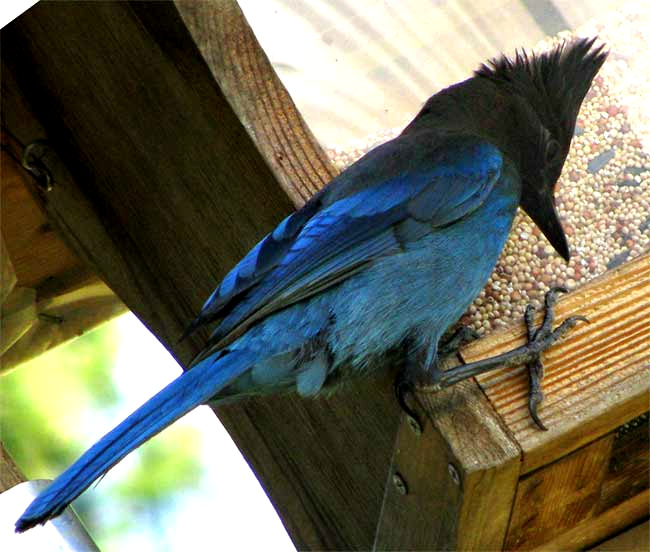
If you live in a city or town with trees along streets, houses with lawns, a park not too far away, maybe a nearby golf course or abandoned lot, possibly some bushy hedges or lines of trees separating homes, that can be pretty good for finding birds. The chances improve a lot if in your own backyard you attract birds, as with a birdbath and feeder, as was the case with the Steller's Jay at the left, on a feeder in Oregon. In fact it's entirely possible that in your own neighborhood you may be able to see a greater variety of bird species than if you sought them only deep inside a forest.
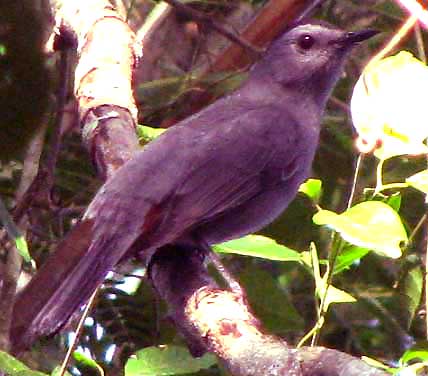
That's because deep inside a forest normally you find only birds adapted for being deep inside forests. However, in cities and towns there are many patches of distinct habitats, and each habitat can support its own characteristic assemblage of bird species. For example, in North American towns with tall, bushy hedges between properties, sometimes the Gray Catbird, shown at the right lurks in shadows below the hedge. Various seed-eating birds such as sparrows and finches can be spotted foraging on the ground in weedy or grassy areas. Around warehouses, nighthawks may nest on flat roofs, and fly overhead at dusk. Pigeons may make themselves at home in various nooks and crannies of the downtown area. In wetlands along the river you might see marsh birds, and in the park where trees are thick there may be forest birds, and an occasional wild duck or goose on the park lake.
Time of Day
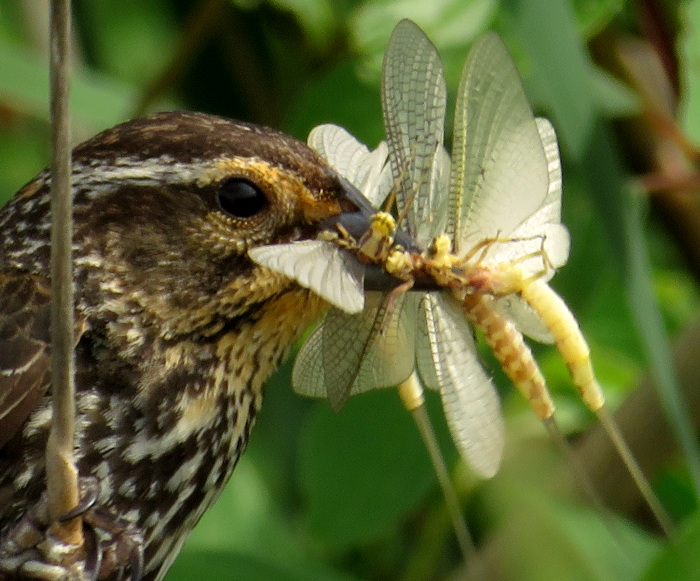 Female Red-winged Blackbird with beakful of Mayflies for nestlings; photo by Laura Maskell in Ontario
Female Red-winged Blackbird with beakful of Mayflies for nestlings; photo by Laura Maskell in OntarioMost birds are much more active during the first two or three hours of the morning, and then again an hour or two before dusk, than during the long middle of the day.
There are some exceptions to this rule. At the beach, sea gulls and shorebirds may stay active the whole day. Hummingbirds often return to feeders throughout the day. During nesting season, birds with young to feed can be seen flying back and forth to their nests all day long, as with the Red-winged Blackbird in the picture.
Time of Year
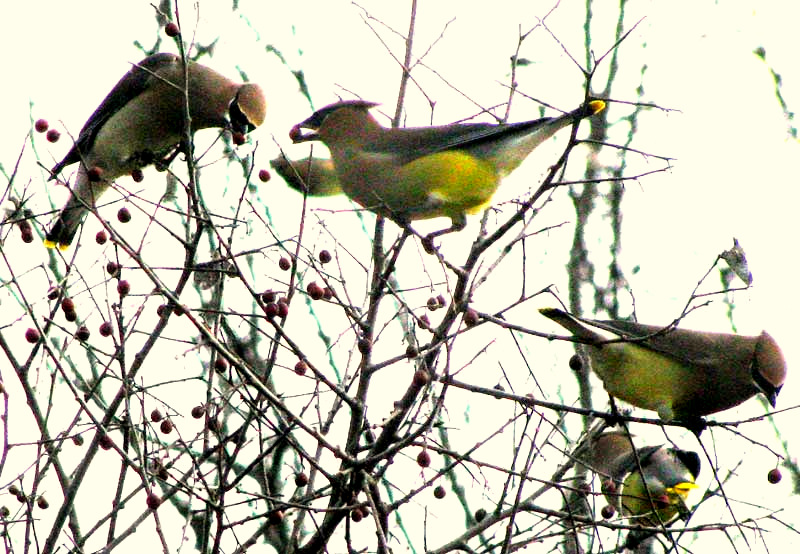
During the nesting season, male birds sing advertisements for females, and later they "defend" their territories with song, so that's a good time for locating a variety of species by tracking down the singer. In late summer and during the fall, some birds join into large, conspicuous flocks with others of their species, making them easier to spot. At the left, during midwinter, Cedar Waxwings gulp fruits on an ornamental hawthorn tree beside a downtown parking lot in Grants Pass, Oregon.
During late fall and again in early spring, a large number of bird species migrate. Some of the greatest fun in birding is seeing birds pass through one's neighborhood during migration. Many species appear in our neighborhoods only at this time.
Your Own Bird-Seeing Talent
As you gain more experience in looking for and seeing birds, your powers of observation will improve profoundly! Spotting birds involves much more than just learning tricks, such as looking into bushes instead of at bush surfaces. It's as if the part of the brain responsible for bird-finding were a muscle -- a muscle that grows larger and stronger the more it's used.
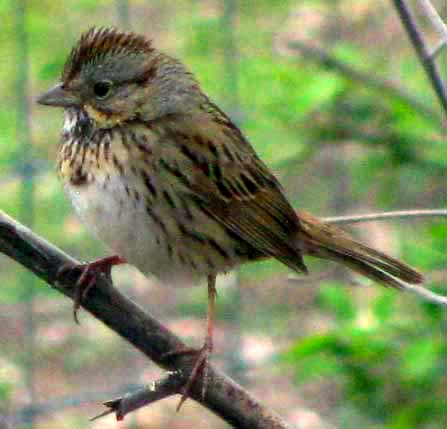
After a few months of practice you'll find yourself catching glimpses of elusive birds where others see nothing. Moreover, when you spot a bird, your brain will automatically soak up an incredible array of details, such as the presence or absence on the bird of eye stripes or rings, wingbars, spots beneath the tail, streaks on the chest, etc. This is true, even if right now when you look at a bird for awhile and then ten seconds after it's flown all you can say is, "It was kind of small, and maybe brownish... " Give yourself a test; Without looking now, does the Lincoln Sparrow in the picture above have a white eye-stripe? A conspicuous eye ring? Wingbars? Dark streaks on the chest? A dark spot on the chest?
Your Ideas about Birds
It may seem funny that your ideas about birds can determine what you see, but it's true. Wrong ideas can inflict you with a kind of bird-seeing blindness.
For instance, you may have noticed that a Saint Bernard and, say, a poodle are very unlike one another, yet they can breed with one another and produce mixed-blood offspring (called St. Berdoodles...). This bit of information and others like it may mingle in your mind, creating the general impression that different-looking groups of birds are more or less just one thing, the appearance of each individual depending on what its parents looked like, or some other unknown cause.
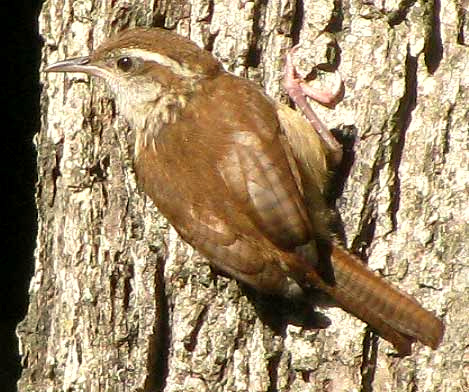
The result may be that when you see a bird you ignore important diagnostic features such as wing bars, eye stripes, and the rest. That's a big error in birding, because, unless there's a mutation or you're dealing with domesticated or semi-domesticated birds such as pigeons, appearances of birds are fairly fixed, not at all squishy. The mature adult Carolina Wren at the left looks almost exactly like any other mature adult Carolina Wren living in the same general area during the same season. The immature plumages of many species are very unlike the adult plumage, but those immature plumages similarly are the same for all immature members of the same species living in the same area. In some species there are big differences between male and female adult plumages, but... You get the idea.
Your Expertise with Your "Tools"
The birder's three main tools are field guides, binoculars, and notes. You can enjoy birds flitting around the feeder without these but, if you want to become even halfway serious about the matter, you must have these things. These tools are described at our "Nature Study Tools" link.
